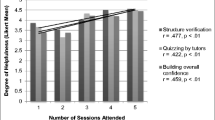Abstract
Problem-based learning (PBL) was developed by McMaster University (MMU) in response to students’ concerns about conventional lecture-based pedagogy. Tulane University School of Medicine (TU) supplemented its traditional lecture and dissection-based curriculum for Gross and Developmental Anatomy with the addition of PBL in 2007. In 2016, TU restructured the PBL modules to resemble the structure of MMU’s PBL. TU eliminated the lecture portion of the old PBLs to enhance interactive self-directed learning, and divided the class into smaller groups to facilitate more student interaction. It was hypothesized that this would increase students’ confidence in their problem-solving skills and enhance overall satisfaction with the PBL portion of the curriculum despite an increase in pre-class workload. Two-hundred first-year medical students were given anonymous surveys after each of the three PBL sessions to assess the students’ overall satisfaction with the PBL. A traditional Likert scale was used and written comments were collected. The TU students valued the revised PBL as a learning tool; specifically, the benefit of pre-class research, small group discussion, close faculty interactions, and clinical application of lecture material. Data collected demonstrated that 89% of students were satisfied with this part of their curricula for each respective PBL, despite the shift of initiative onto the students for self-directed learning in the new PBLs. The education of medical students supplemented by PBLs continues to be a useful tool and can be considered as a positive addition to a Gross and Developmental Anatomy course.


Similar content being viewed by others
References
Donner RS, Bickley H. Problem-based learning in American medical education: an overview. Bull Med Libr Assoc. 1993;81:294–8.
Spaulding WB. The undergraduate medical curriculum (1969 model): McMaster University. Can Med Assoc J. 1969;100:659–64.
Barrows HS. Problem-based learning in medicine and beyond: a brief overview. New Dir Teach Learn. 1996;68:3–12. https://doi.org/10.1002/tl.37219966804.
Norman GR, Schmidt HG. The psychological basis of problem-based learning: a review of the evidence. Acad Med. 1992;67:557–65.
Vernon DTA, Blake RL. Does problem-based learning work? A meta-analysis of evaluative research. Acad Med. 1993;68:550–63.
Habib F, Baig L, Mansuri FA. Opinion of medical students regarding problem-based learning. J Pak Med Assoc. 2006;56:430–2.
McLean M. A comparison of students who chose a traditional or a problem-based learning curriculum after failing year 2 in the traditional curriculum: a unique case study at the Nelson R. Mandela School of Medicine. Teach Learn Med. 2004;16:301–3. https://doi.org/10.1207/s15328015tlm1603 15.
Birgegard G, Lindquist U. Change in student attitudes to medical school after the introduction of problem-based learning in spite of low ratings. Med Educ. 1998;32:46–9.
Needham DR, Begg IM. Problem-oriented training promotes spontaneous analogical transfer: memory-oriented training promotes memory for training. Mem Cogn. 1991;19:543–57.
Kantar LD, Massouh A. Case-based learning: what traditional curricula fail to teach. Nurse Educ Today. 2015;35:8–14. https://doi.org/10.1016/j.nedt.2015.03.010.
Harman T, Bertrand B, Greer A, Pettus A, Jennings J, Wall-Bassett E, et al. Case-based learning facilitates critical thinking in undergraduate nutrition education: students describe the big picture. J Acad Nutr Diet. 2014;115:378–88. https://doi.org/10.1016/j.jand.2014.09.003.
Kelly PA, Haidet P, Schneider V, Searle N, Seidel CL, Richards BF. A comparison of in-class learner engagement across lecture, problem-based learning, and team learning using the STROBE classroom observation tool. Teach Learn Med. 2010;17:112–8. https://doi.org/10.1207/s15328015tlm1702 4.
Srinivasan M, Wilkes M, Stevenson F, Nguyen T, Slavin S. Comparing problem-based learning with case-based learning: effects of a major curricular shift at two institutions. Acad Med. 2007;82:74–82.
Thistlethwaite JE, Davies D, Ekeocha S, Kidd JM, MacDougall C, Matthews P, et al. The effectiveness of case-based learning in health professional education. a BEME systematic review: BEME Guide No. 23. Med Teach. 2012;34:e421–44. https://doi.org/10.3109/0142159X.2012.680939.
Mechaelsen LK, Sweet M. Team-based learning. New Dir Teach Learn. 2011;128:41–51. https://doi.org/10.1002/tl.467.
Dyrbye LN, Thomas MR, Harper W, Massie FS Jr, Power DV, Eacker A, et al. The learning environment and medical student burnout: a multicenter study. Med Educ. 2009;43:274–82.
Zgheib NK, Simaan JA, Sabra R. Using team-based learning to teach clinical pharmacology in medical school: student satisfaction and improved performance. J Clin Pharmacol. 2011;51:1101–11.
Shin JH, Haynes RB, Johnston ME. Effect of problem-based, self-directed undergraduate education on life-long learning. CMAJ. 1993;148:969–76.
Karpicke J, Roediger HL 3rd. The critical importance of retrieval for learning. Science. 2008;319:966–8. https://doi.org/10.1126/science.1152408.
Schmidt HG, De Volder ML, De Grave WS, Moust JHC, Patel VL. Explanatory models in the processing of science text: the role of prior knowledge activation through small-group discussion. J Educ Psychol. 1989;81:610–9.
Curran VR, Sharpe D, Forristall J, Flynn K. Student satisfaction and perceptions of small group process in case-based interprofessional learning. Med Teach. 2008;30:431–3. https://doi.org/10.1080/01421590802047323.
Gijselaers WH. Connecting problem-based practices with educational theory. New Dir Teach Learn. 1996;68:13–21.
Hitchock MA, Anderson AS. Dealing with dysfunctional tutorial groups. Teach Learn Med. 1997;9:19–24. https://doi.org/10.1080/10401339709539808.
O’Neill PA, Morris J, Baxter CM. Evaluation of an integrated curriculum using problem-based learning in a clinical environment: The Manchester Experiment. Med Educ. 2000;34:222–30.
Author information
Authors and Affiliations
Corresponding author
Ethics declarations
Conflict of Interest
The authors declare that they have no conflict of interest.
Rights and permissions
About this article
Cite this article
Ransom, A.L., Nieto, L.E. & Korndorffer, M.L. Impact of Redesigned Anatomy Problem-Based Learning Curriculum on Student Satisfaction. Med.Sci.Educ. 27, 895–901 (2017). https://doi.org/10.1007/s40670-017-0479-0
Published:
Issue Date:
DOI: https://doi.org/10.1007/s40670-017-0479-0




